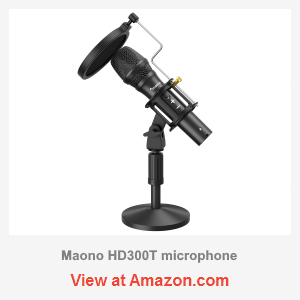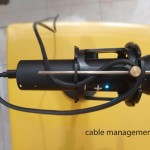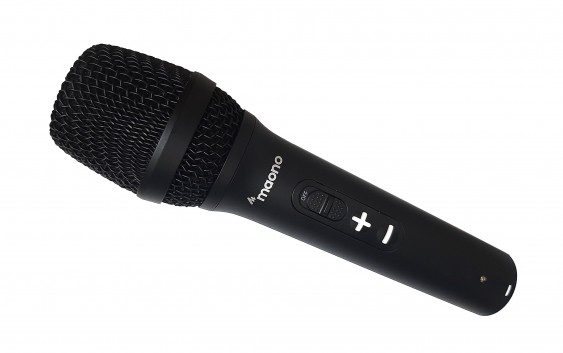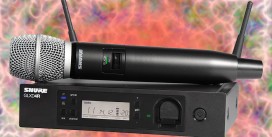Maono HD300T is a dynamic USB microphone that brings live sound home and packs the best bang for the buck when it comes to vocal recording. It delivers the best traits of dynamics that result in smooth and undistorted sound, saving you from buying expensive equipment such as preamps and digital interface that are otherwise necessary for connecting a dynamic XLR microphone to a computer. This mic comes with handy shock mount & compact pop filter, only lacking a boom arm for a complete podcast package. Despite the good quality on vocals, this is not necessarily a replacement for the everyday use desktop mics because of its size and potential lack of gain when miking from a distance.
Sound & quality
The sound quality of the microphone is very good overall – performing alike units twice and triple the price, it just destroys anything under $100. There are many aspects to it but we shall start with the frequency response. By the way, all the specs are readily available in the documentation, for which lots of kudos to Maono, because usually producers hide this info when it comes to budget mics. So, the frequency response of HD300T is actually flat, it has very little coloration and therefore gives you a quite accurate tonal representation. It could be described as neutral with just a touch of warmth, working very well for announcements and vocals.
The roll off starts at 90 Hz and goes 10 dB / octave meanwhile upper highs receive some boost in the 7-10 kHz region, giving it more presence and clarity, and even extend to 15 kHz. This is a very good curve for a dynamic mic, and especially for a USB mic… The highs are transparent, silky and smooth; the mid-tones are neutral and the lows are just natural. Condensers, in comparison may sound a bit more detailed but usually also harsher, which is not ideal especially for the beginners who have not yet mastered their recording techniques. On the other hand, HD300T does not fall behind in terms of clarity either, and everything contributes to easy use.
There are actually even more advantages compared to condensers: you can stay right on top of it without overloading the mic or causing some unpleasant proximity effects – Maono handles it very well. And the closer you are to the mic, the higher signal to noise you get against the background. Condensers usually like a bit more distance thus also picking up more background. Another advantage is that it handles the wind very well. This may sound irrelevant at first, but in reality blowing into mic while singing or even breathing is very common. Compared side by side with Shuve MV5, there is a night and day difference in this regard.
Comparison
 There are however some disadvantages too with the HD300T. Those aren’t even about the quality of the recording, but rather regarding its utility. The first thing you’ll notice is that it doesn’t have that much gain compared to more common condenser mics. For speech, you may want to keep the gain slider at 100% and only when singing up close will you have to lower it. If you can always be on top of the mic, this isn’t a problem at all. However, if you like to lean back leaving it on your desk – this will not work. It simply won’t have enough gain to pick up the sound from afar. There is no way to set it above 100% and since it’s only 16-bit depth, boosting in DAW may not be lossless either.
There are however some disadvantages too with the HD300T. Those aren’t even about the quality of the recording, but rather regarding its utility. The first thing you’ll notice is that it doesn’t have that much gain compared to more common condenser mics. For speech, you may want to keep the gain slider at 100% and only when singing up close will you have to lower it. If you can always be on top of the mic, this isn’t a problem at all. However, if you like to lean back leaving it on your desk – this will not work. It simply won’t have enough gain to pick up the sound from afar. There is no way to set it above 100% and since it’s only 16-bit depth, boosting in DAW may not be lossless either.
Another issue is that the real-time monitoring output does not provide the best audio quality. It does get quite loud in comparison to that of the ALC887 in my motherboard, so I was able to hear myself clearly while recording. However, it just isn’t the best sound if you are trying to master or your recording, even applying EQ is going to be out of the window. So as soon as you’re done recording, you want to use a better DAC or switch to your studio monitors. My headphones have 16-Ohm impedance, so when I plug them into the mic, there is not enough power to drive them. As a result, I found the low frequencies, such as 50 Hz were non-existent during playback.
For comparison, Audio-Technica AT2005USB has the exact same drawbacks: potentially lacks gain and provides even less power from the DAC into low impedance loads. Those things aren’t deal breakers of course, but it’s always good to understand what you are getting beforehand to keep yourself from dissatisfaction. The Audio-Technica mic by the way has a brighter response, more appropriate for stage use rather than home recording, whereas Maono is mellower-sounding. Since it also comes with shock mount and pop filter, I’d say Maono actually takes the upper hand. I am a big fan of accessories, because in the end they help improving the sound at no additional cost.
Durability
 In terms of durability, HD300T looks very solid but once you hold it in your hand, it will feel even more solid. It weighs no less than the regular XLR vocal mics and has a full aluminum, metal body. The grilles also look nice, so I suppose it has to be durable, or at least its dynamic component. When it comes to the USB and active components, we may need a little bit more feedback from the users because this review is ahead of the actual release. One thing that concerns me is the unjustified use of the USB-C port, which feels a little bit wobbly and I wouldn’t want to strain it. Just to be on the safe side I’ve come up with a cable management loop, luckily the cable is long enough to allow this.
In terms of durability, HD300T looks very solid but once you hold it in your hand, it will feel even more solid. It weighs no less than the regular XLR vocal mics and has a full aluminum, metal body. The grilles also look nice, so I suppose it has to be durable, or at least its dynamic component. When it comes to the USB and active components, we may need a little bit more feedback from the users because this review is ahead of the actual release. One thing that concerns me is the unjustified use of the USB-C port, which feels a little bit wobbly and I wouldn’t want to strain it. Just to be on the safe side I’ve come up with a cable management loop, luckily the cable is long enough to allow this.
- Reviewed at $69.99
Pros
|
Cons
|









